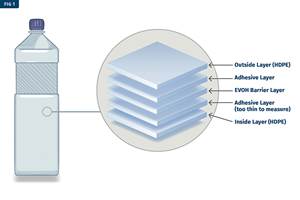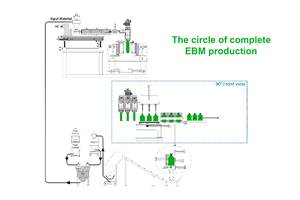Downward Pricing Pressure for Commodity Resins this Quarter
Slowed demand, sufficient supplies, lower global prices could serve to push down prices of most commodity resins.
The year’s last quarter started with signals that prices of PE, PP, PS, PVC, and possibly PET, despite suppliers’ price increase attempts, would drop or remain flat. Among the main drivers are ample supplies, falling global prices, and in some cases off demand. PET could be the exception as there are market projections for higher prices for its key feedstocks.
Here’s a recent takeaway at how our industry colleagues with pricing expertise view things for each of the five major commodity volume resins. They include purchasing consultants from Resin Technology, Inc. (RTi), Fort Worth, Texas, senior editors from Houston-based PetroChemWire; and CEO Michael Greenberg of the Plastics Exchange in Chicago.
▪ PE: Prices moved up 3¢/lb on September as suppliers pushed to reclaim at least part of the 6¢/lb loss of previous months. While the move was largely attributed to a September weather event in the Texas Gulf Coast, there were no reported force majeures and transportation and infrastructure in the PE segment was restored quickly, say Mike Burns, RTi, v.p. of PE markets and PCW’s senior editor David Barry. There also reports of a new 8¢/lb increase, effective Oct. 1, with one supplier coming out with 4¢/lb. The Plastic Exchange’s Greenberg reports that while there might be some reasoning behind the September hike, implementation of the additional October increase(s) is very unlikely barring another major storm or escalation from the Saudi attacks.
Both Burns and Barry ventured that the 3¢/lb increase would most likely come off in the October-November time frame barring a major disruption. Says Burns,“Processors are in the best position in years to negotiate new year contracts.” He ventures that Southeast Asian PE prices could have a significant impact on late fourth quarter prices; noting that the low regional prices are stalling exports which will serve to increase suppliers’ inventories and can translate to downward pricing. Barry notes that while more new capacity is slated to come on stream, startup of most projects is being delayed.
▪ PP: Prices last month appear to have moved up by 1¢/lb in step with propylene monomer contracts. The slight increase was attributed partially to an ExxonMobil propylene cracker fire and the Saudi Arabian oil fields drone strikes. Both PCW’s Barry and Scott Newell, RTi’s v.p. of PP markets anticipate that PP prices will be relatively stable in the Oct.-Nov. time frame, give or take a penny.
Newell characterizes demand as stagnant with many key markets showing negative growth compared to 2018, including automotive, consumer goods, and film sectors. He notes that PP suppliers’ inventories have increased by 55 million lb and days of supply are at 38, which translates to a very well supplied market. Both Newell and Barry see PP processors as having more of an edge on 2020 contract negotiations as a result of the supply/demand imbalance.
Greenberg describes spot PP trading as very strong by September’s end, with ample supply. He reports that while PP contract prices would likely settle up by 1¢/lb along with monomer costs, “good resin availability remained and supply risks appeared benign.” As a result, as September, ended spot prices for both homopolymer and copolymer PP grades ticked lower by a full cent.
▪ PS: Prices were flat in September, following a 1¢/lb drop in August. One supplier is out with a 3¢/lb increase, effective October 1, while another indicates flat pricing. Both PCW’s Barry and Robin Chesshier, RTi’s v.p. of PE, PS and nylon 6 markets, say a slight increase in September benzene contract prices (5¢/gal) to $2.60/gal is still lower than the year’s low of $2.66/gal in July. Moreover, low spot styrene monomer and butadiene prices—41¢/lb and 37.5¢/lb, respectively—do not back up a price hike.
Both sources say prices in Asia for both monomer and PS have been dropping, and that barring a major global disruption, prices this month are likely to remain flat with some potential for further PS price erosion later in the month and in the Nov.-Dec. time frame. “Benzene will be the main driver,” she says.
▪ PVC: Prices in September were flat following the August 1¢/lb decrease. PCW’s senior editor Donna Todd reports that while buyers were glad to see the predicted August decrease, they were disappointed that another industry-projected 1¢/lb decrease last month did not take place. Meanwhile, suppliers are out with a 3¢/lb increase, effective October 1.
Both Todd and Mark Kallman, RTi’s v.p. of PVC and engineering resins, are skeptical about suppliers’ move due to both a weak export market and a domestic market that never quite recovered from its early season delay. Says Kallman, “While demand has been steady, the market has not seen the boost that was expected.” Both sources say suppliers are hinging their move on higher spot ethylene prices due to some production disruptions.
Late unsettled ethylene contract prices for August and September were expected to end up as a two-month settlement, rising by more than 2¢/lb. If it settles up 3-4¢/lb, it would translate to a 2¢/lb cost increase to produce PVC. RTi’s Kallman ventures PVC prices this month will be flat to up 1¢/lb, followed by flat pricing in November. PCW’s Todd ventures that there is potential for a further 1¢/lb decline before year end. “Export prices have been falling in concert with Asian prices, which is expected to put pressure on the domestic market and make a domestic price increase difficult to achieve,” she reports.
▪ PET: Prices ended September at 47-51¢, down from 50-53¢/lb at the end of August. This price is for most imported resin from around the world as well as domestically produced PET, says PCW senior editor Xavier Cronin. Meanwhile, offgrade PET and ‘penciled-down’ prime PET (resin sold as offgrade when a seller needs to get rid of inventory) was seen a few cents lower.
Cronin says PET prices for October started out steady. However, he indicates some market sources project that prime PET prices could rise starting within this month and the rest of the year, due to expected higher global costs for PET feedstock, including PTA and MEG in the fourth quarter. Possibly up by 4¢lb+, according to one U.S.-based PET resin seller source.
Demand remains weak due to the end of the heavy PET seasonal consumption period, itself tied to increased use of single-serve PET bottles and containers in most U.S. locations. Cronin cited current industry estimates that three in 10 PET bottles used in the U.S. are recycled; most of what’s not recycled is exported, landfilled or ends up as litter.
Related Content
Best Methods of Molding Undercuts
Producing plastics parts with undercuts presents distinct challenges for molders.
Read MoreFoam-Core Multilayer Blow Molding: How It’s Done
Learn here how to take advantage of new lightweighting and recycle utilization opportunities in consumer packaging, thanks to a collaboration of leaders in microcellular foaming and multilayer head design.
Read MoreMeasuring Multilayer Plastic Containers Made Easier With Today's Ultrasonic Gauges
Ultrasonic gauge technology has evolved to simplify measurement of very thin layers in plastic containers. Today’s gauges with high-frequency capabilities and specialized software can make multilayer container measurement quick and easy for ordinary users.
Read MoreGet Color Changes Right In Extrusion Blow Molding
Follow these best practices to minimize loss of time, material and labor during color changes in molding containers from bottles to jerrycans. The authors explore what this means for each step of the process, from raw-material infeed to handling and reprocessing tails and trim.
Read MoreRead Next
Lead the Conversation, Change the Conversation
Coverage of single-use plastics can be both misleading and demoralizing. Here are 10 tips for changing the perception of the plastics industry at your company and in your community.
Read MorePeople 4.0 – How to Get Buy-In from Your Staff for Industry 4.0 Systems
Implementing a production monitoring system as the foundation of a ‘smart factory’ is about integrating people with new technology as much as it is about integrating machines and computers. Here are tips from a company that has gone through the process.
Read MoreMaking the Circular Economy a Reality
Driven by brand owner demands and new worldwide legislation, the entire supply chain is working toward the shift to circularity, with some evidence the circular economy has already begun.
Read More





















 (2).jpg;maxWidth=300;quality=90)








